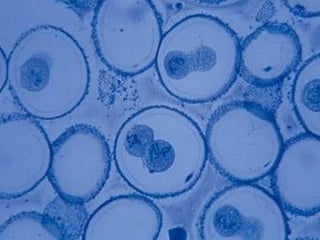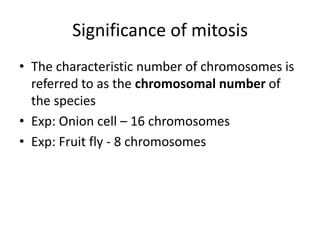Mitosis Lesson 2
- 1. CURIOSITY is the KEY to CREATIVITYNeeds are never the key to creativity
- 2. Creativity is not artistic, but PROBLEM SOLVERE.g.: Apple Inc CEO, Steve Job
- 3. When you stop to ask questions, you stop growing
- 4. Study is not about exam, but the excitement when you learn something new ïRebecca Choong, 2010
- 5. Task (1):Each one of you, please think of FIVE (5) questions you would like to know about cell division. Youâre free to be WILD in your question
- 6. Task (2):Each group please compose all question and make it into a group list
- 8. Task (4)Which question that you think is very creative?
- 10. Cells in living things do not last forever, for theyâĶWear out after some timeGet damaged (through cuts, by ultraviolet radiation or by hazardous environmental pollutants)Grow old naturally and die
- 11. Importance of new cells produced are genetically identical to their parent cells:Continue with the specific cell functions of their parent cells within a particular tissueAvoid disrupting the stable internal environment of life or its processesProduce offspring that have the complete functions of an adult organism (in asexual reproduction) to ensure the survival of that species
- 12. Significance of mitosisNucleus contains chromosomes.Each chromosome consists of a long DNA molecule which carries genes in a linear sequenceGene determines the individual characteristics of an organism
- 13. Significance of mitosisThe characteristic number of chromosomes is referred to as the chromosomal number of the species Exp: Onion cell â 16 chromosomesExp: Fruit fly - 8 chromosomes
- 14. Significance of mitosisSomatic cells have two sets of chromosomes, one set inherited from each parent.Each cell contains a diploid number of chromosomes (2n)In humans, each set consist of 23 chromosomes.Typical human somatic cell, 46 chromosomes arranged in 23 pairs or 2n = 46
- 15. Significance of mitosisThe two chromosomes in each pair have the same structural features and are referred to as homologous chromosomes
- 16. Significance of mitosisGametes contain only one set of unpaired chromosomes, or haploid number of chromosomes (n)
- 17. Cell Cycle
- 18. Uncontrolled Mitosis in Living ThingsCancerCancerous cell - tumour
- 20. Application of mitosisTissue culture
















